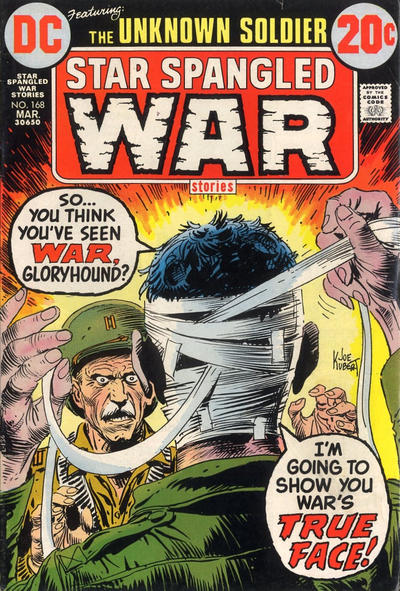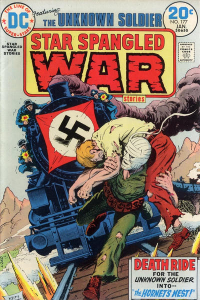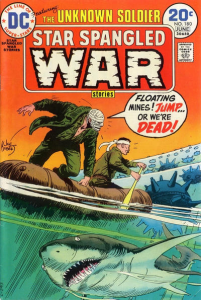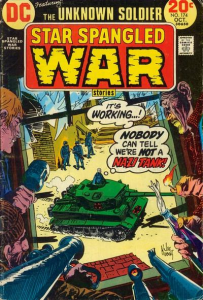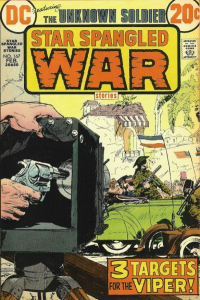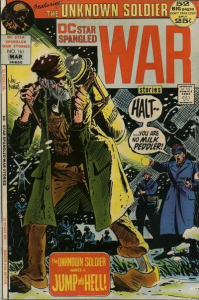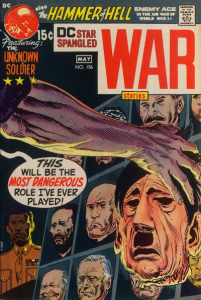There is a whole branch of spy fiction focusing on World War II going back to the time of the conflict itself. In cinema, the British kicked things off with thrillers such as Night Train to Munich and Contraband. Hollywood followed suit with a bunch of neat productions: Five Graves to Cairo, Journey into Fear, Northern Pursuit, The Conspirators, Ministry of Fear, the list goes on and on (those of you into grim ‘n gritty make sure to check out Lewis Milestone’s Edge of Darkness).
This subgenre outlived the war and mutated along the way, but by the late ‘60s and ‘70s it was still bringing to the big screen such riveting movies as Where Eagles Dare and The Eagle Has Landed. It was also around this time that DC put out its finest foray into the field of WWII spy yarns, in the form of The Unknown Soldier…
The Unknown Soldier made his debut in ‘They Came from Shangri-La!’ (Star Spangled War Stories #151, cover-dated June-July 1970), written, edited, and drawn by Joe Kubert. [edit: It turns out that, although this was the first story of his own feature, the character’s debut had actually taken place in an earlier Sgt. Rock comic, ‘I Knew the Unknown Soldier!’ (Our Army at War #168, June 1966), by Robert Kanigher and Joe Kubert.] A veteran of the industry, Kubert was one of the undisputed masters of war comics (he had already enriched DC’s portfolio with the creation of Sgt. Rock and Enemy Ace) and he found a versatile new angle here: the Unknown Soldier was a chameleonic US agent with an expertise on the various areas of the military, so you could throw him into pretty much any kind of tale. The faceless character was also a pretty explicit embodiment of the US fighting spirit and armed forces, lending himself to easy symbolism (especially as he was often framed near his namesake monument in Washington). When he was not on a mission, the Unknown Soldier wore bandages around his head (a la the Invisible Man), which visually represented both his anonymity and the sacrificial violence of war.
Having established this winning concept (including an origin story after three issues), Kubert gradually passed the torch to other competent hands. In terms of writing, he brought in Bob Haney, who churned out dynamic scripts like nobody’s business – and who further developed the series’ gimmick, revealing that the Unknown Soldier had a collection of face masks in his Washington headquarters that he wore over his bandages (yes, over the bandages) while on the field. Jack Sparling took over the art and, after a couple of years, the great Archie Goodwin took over as editor – at first editing his own scripts and later handing writing duties over to Frank Robbins.
Despite the changes to the creative team, the series’ style remained relatively consistent. For one thing, it was always first and foremost a war comic… At one point, Kubert even recycled a Sgt. Rock story he had done with Robert Kanigher for Our Army at War back in 1960, including this tense page:
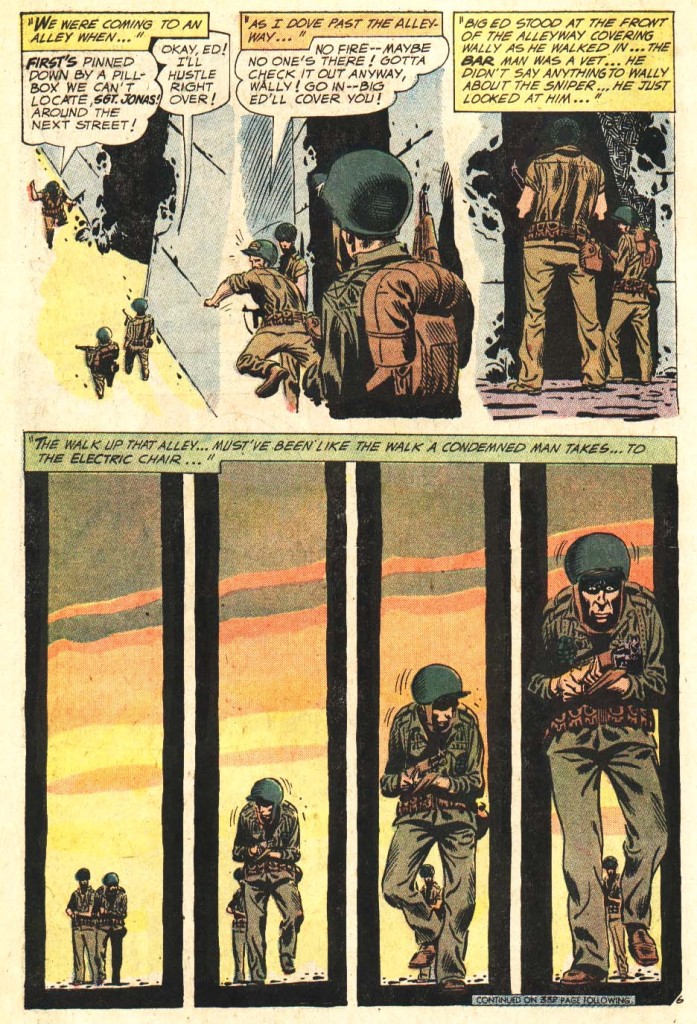 Star Spangled War Stories #162
Star Spangled War Stories #162
That said, there was an undeniable element of espionage involved, if nothing else because the Unknown Soldier was always going on secret missions and pretending to be someone else. Tales like ‘The Long Jump’ (set in Nazi-occupied Holland) and ‘Three Targets for the Viper!’ (set in Morocco, with the obligatory nod to Casablanca) are in the mold of old-school WWII spy adventures and wouldn’t look too out of place as storyboards for classic Hollywood. Hell, between the face masks and the plot twists, ‘Destroy the Devil’s Broomstick!’ (set in a Japanese submarine) feels like an episode of the original Mission: Impossible TV series!
The whole thing oozed with suspense and deception. There were codes and passwords, disguises and fake identities, violent action and a constant sense of danger, usually culminating in scenes where the Unknown Soldier had to bullshit his way out while a German or a Japanese officer pointed a gun at him.
Moreover, besides infiltrating the enemy, our hero did counterintelligence operations, often detecting Nazi spies among the Americans, for example in the gripping ‘Kill the General’ and ‘The True Glory.’
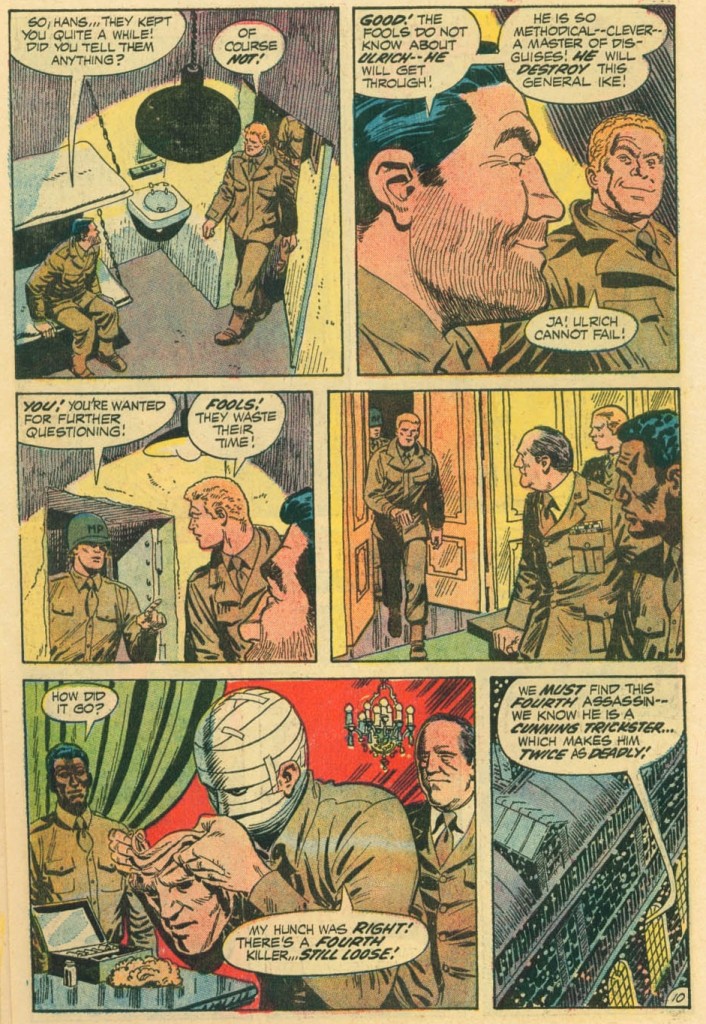 Star Spangled War Stories #163
Star Spangled War Stories #163
If it seems odd that such gung-ho comics were coming out during the controversial Vietnam War, bear in mind that, while the US forces weren’t normally depicted unfavorably, these stories were smarter and more nuanced than mere jingoistic yarns about American soldiers kicking ass… Despite a few caricatural villains, there was a general sense that the war was made up of vulnerable humans and conflicted individuals. This was especially the case in the tales of Archie Goodwin, who tended to temper seemingly heroic actions with ironic twists, exposing the murky morality of the war context.
It wasn’t just that some of the US troops were shown as fallible – militarily as well as ethically. More than once, the Unknown Soldier completed his assignment thanks to the sympathetic help of someone from the opposite side, including people who had lost loved ones because of his actions (although they were usually unaware of his role, which was particularly heartbreaking to see).
Plus, in a fascinating move, between mid-1971 and late 1972 the last panel of each tale in Star Spangled War Stories finished with a stamp saying ‘Make War No More.’ In the case of the Unknown Soldier’s tales, this meant that, even though we inevitably rooted for the successful completion of the hero’s mission, there was always something downbeat about the ending…
 Star Spangled War Stories #159
Star Spangled War Stories #159
Indeed, for all the thrilling games of cat-and-mouse, The Unknown Soldier didn’t disregard the grim background of the war, including the specificities of WWII. Archie Goodwin, who had been behind the hard-hitting anti-war series Blazing Combat, brought a similar flavor to tales such as ‘The Glory Hound!’ (where the Unknown Soldier denounced the fake glamour of battle by showing his scarred face to an eager captain). Frank Robbins probably watched Hell in the Pacific before penning ‘The Doomsday Heroes!’ As for Bob Haney’s ‘Totentanz,’ it’s probably one of the grimmest slice of comics to come out of the early ‘70s… Joe Kubert even opens it with a collage that includes photos of corpses from Nazi concentration camps!
This kind of opening photocollage – disturbingly stressing the series’ links to real world events – soon became a trademark of the comic:
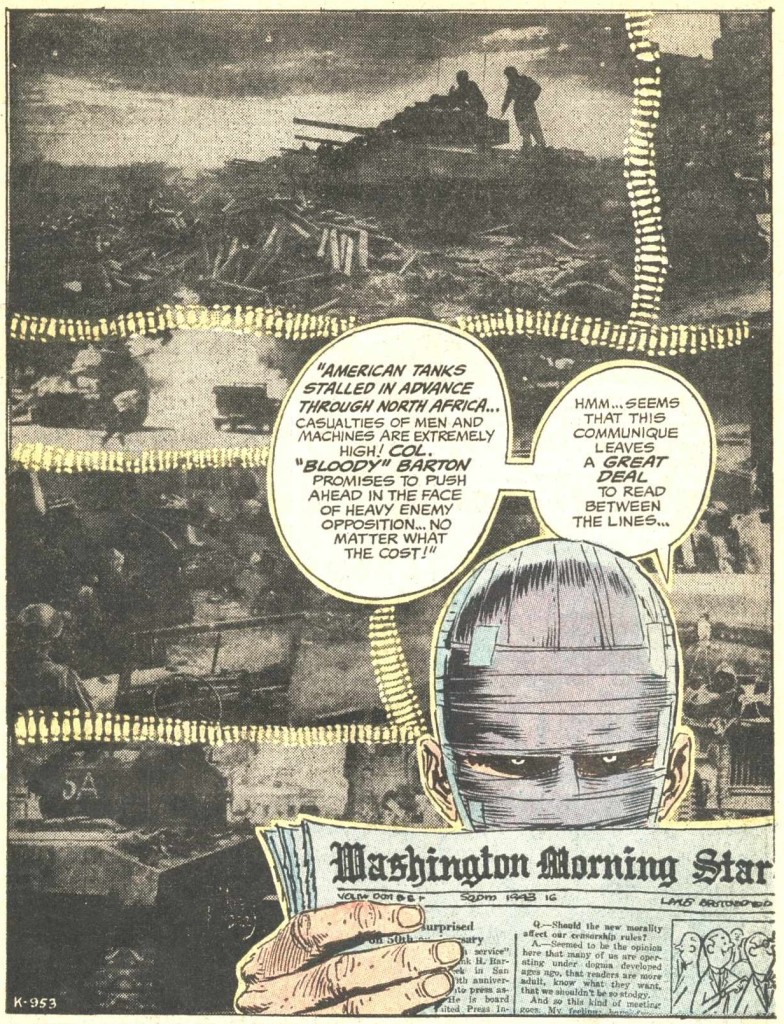 Star Spangled War Stories #159
Star Spangled War Stories #159
And then there is ‘A Town Called Hate!’ Set in a small French town, in this remarkable tale the Unknown Soldier has to deal with a deadly confrontation between US troops and a corps of African American engineers. Frank Robbins’ previous attempts to address racial tension (including in the Batman story ‘Blind Justice… Blind Fear!’ in Detective Comics #421) had not been incredibly sophisticated, but this one has a lot going for it, exposing the persistence of American racism even as Washington claimed to be fighting against the Nazis’ racist ideology. Although the emphasis on blacks and whites overcoming their bigotry in order to fight the common (external) enemy can be seen as a reactionary, Cold War-tinged downplaying of domestic racial issues, the powerful ending actually feels closer to the cynical punchline of The Hateful Eight.
That said, at the end of the day The Unknown Soldier was still a comic heavily shaped by Bob Haney, so it was not above some pulp trappings. Always one for corny nicknames, Haney’s purple narration kept calling our hero ‘the immortal man of war’ and ‘the man nobody knows, yet is known by everyone…’ – and the ensuing writers kept this approach. Thus, there was a discernible tension between the comic’s clear desire to entertain and the inescapable self-awareness that came with fictionalizing warfare at such politically charged times.
I think Frank Robbins proved to be particularly deft at negotiating this tension. After years of standalone tales, he turned the series into more of an ongoing saga, introducing other recurring characters and multi-part storylines, starting with the awesome ‘Operation SNAFU!’ (Star Spangled War Stories #174). His work had a truly appealing two-fisted thriller vibe, culminating in a quest in the Philippine jungle that had quite personal stakes for the Unknow Soldier.
In late 1974, however, the underlying tension finally burst as the series’ lingering themes were faced head-on by an entirely new creative team. We’ll talk about that next week.

